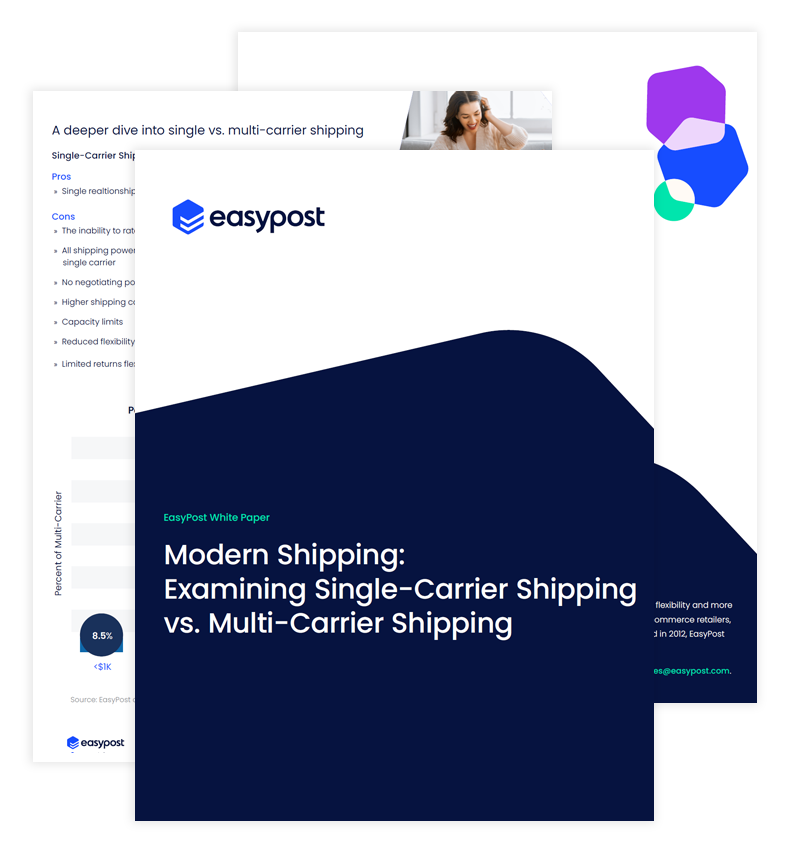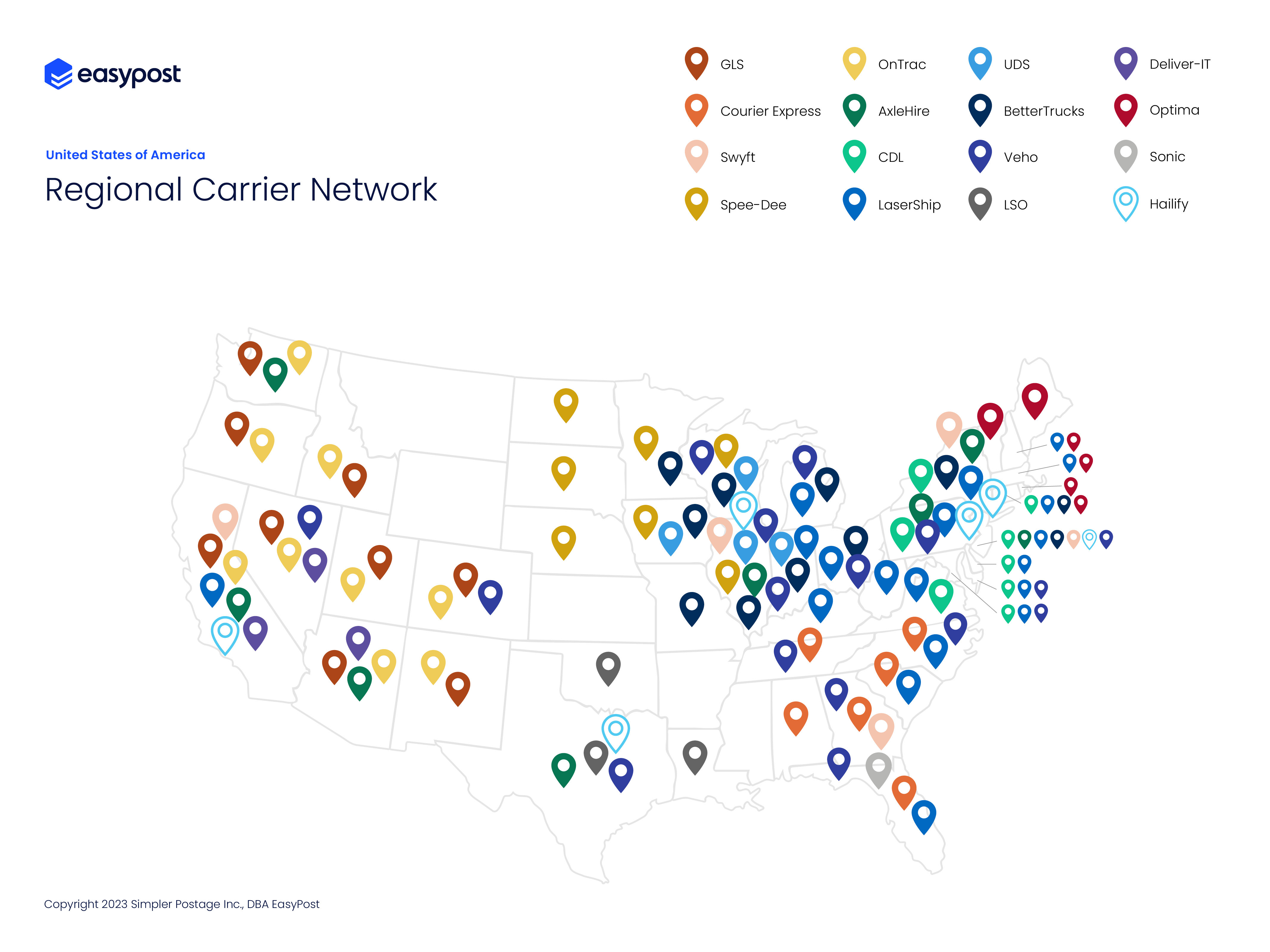Why Multi-Carrier Shipping Software Is a MUST
Topics covered in this article
- Background
- Let's have a conversation. Your customers will thank you.
- The detriments of single-carrier shipping
- Why multi-carrier shipping is a winning strategy
- What is multi-carrier shipping?
- The benefits of using a multi-carrier shipping software
- Choose the best multi-carrier shipping software
- Key takeaways
- Ready to talk with a shipping expert?
Background
Today's businesses are under more pressure than ever to quickly deliver packages to the doorsteps of online shoppers. To do so as efficiently as possible, ecommerce businesses need to tap into the most affordable and efficient mail carrier to deliver their products.
Years ago, it was commonplace for businesses to solely rely on one carrier for the scope of their shipping needs. Companies could access predictable shipping costs and delivery guarantees through their singular carrier, and each carrier had an accurate and predictable forecast volume.
While it used to be preferred that shippers only utilized one carrier to help them negotiate rates and streamline the process, this approach is becoming increasingly outdated (and expensive).
As the online shopping landscape continues to evolve and consumers' attention spans dwindle, businesses must begin to leverage multi-carrier shipping software for their ecommerce shipping solutions.
Relying on single-parcel shipping strategies is an approach of the past. This is where the importance of a multi-carrier shipping partner comes into play.
Let's have a conversation. Your customers will thank you.
Our previous shipping integrations were at best clunky, noisy, and riddled with errors. EasyPost truly changed the game for us, and we and our customers are reaping the benefits.
MATTHEW BERK
CEO at Bean Box

The detriments of single-carrier shipping
There are many pain points associated with single-carrier shipping, all of which ultimately put your business at risk of delivering delayed packages and frustrating customer experiences. Single-carrier shipping is a risk that doesn't come without red flags.
Choices minimized
Because you're only interacting with one carrier, you're missing out on the opportunity to get more affordable shipping rates. This may not seem like a huge deal, but your customers may be the ones who feel the impact of this the most, as you may only be providing them with shipping options such as same-day shipping or next-day shipping. If you want to offer additional shipping speeds to your customers, either you or they will have to absorb the costs.
Higher shipping costs
Lack of choice means fewer available shipping rates at your disposal. Let's say you've been using one carrier for your shipping needs and this carrier implements a surcharge ahead of peak shipping season. The pandemic was a perfect example of changes in shipping surcharges that impacted companies across the globe.
Businesses have no choice but to pay these surcharges that will quickly add up across millions of packages. Regional carriers, on the other hand, are more willing to absorb surcharges as opposed to passing them along to their customers.
Capacity limits
With so many businesses relying on the same handful of carriers, it's not surprising that these carriers quickly reach capacity. Capacity limits became more prevalent than ever in the wake of the pandemic as delays and increased demand caused bottlenecks across the board. Surcharges can be significant; you may not think that an increase of $4 per package isn't a lot, but multiply this times millions of packages and you'll see the impact.
Continuously exceeding your agreed-upon package averages can also result in terminated contracts with your carrier. Although this isn't common, it's happened to companies in the past.
Reduced flexibility
Agility and flexibility are the names of the game in today's shipping world. Relying on a single carrier creates additional constraints when it comes to fulfillment, 3PLs, distribution centers, etc. For example, if your carrier's distribution center is far away from your customers, this single channel will take longer to deliver your packages.
Why multi-carrier shipping is a winning strategy
Multi-carrier shipping can take your logistics to the next level. Compared to single-carrier shipping, this strategy saves time and money – and makes for happier customers. In this white paper, you'll learn how multi-carrier shipping software can enhance your business, compared to a single-carrier strategy.

What is multi-carrier shipping?
Multi-carrier shipping refers to using a diverse carrier mix to assist with package delivery. Instead of relying on one carrier to deliver all of your packages, you can instead tap into both national and regional carriers to deliver packages to your consumers.
Multi-carrier shipping software such as EasyPost makes it easier than ever to tap into multiple carriers through a single integration. This type of carrier software allows shippers to directly compare rates and choose the carriers that are best suited for their delivery needs. Rather than forming relationships and dialogues with individual carriers, shippers can lean on EasyPost to navigate these relationships on their behalf.
The benefits of using a multi-carrier shipping software
Shipping to consumers through multi-carrier shipping software comes with a host of benefits you may not have considered.
Keep up with rising ecommerce demand
Ecommerce is only continuing to grow, as experts predict ecommerce revenue in the United States increase by nearly 500 billion dollars between 2023 and 2027. Although the COVID-19 pandemic prompted massive growth in the ecommerce industry, this growth isn't going away any time soon.
As a result of this explosive growth, it's important your business is set up to handle the increased shipping volume. Utilizing multiple carriers can help businesses successfully keep up with increased shipping demand while offering them the flexibility and scalability to make changes as needed.
Directly compare shipping performance
KPIs are important to track in the shipping industry. Ask yourself the following questions about your current shipping carrier(s):
- What percentage of your packages are being delivered on time?
- Are customers receiving packages intact?
- Is your carrier providing you with guarantees when it comes to delivery dates?
- Is it easy to get a hold of your carriers if you need to resolve a particular issue?
Utilizing multiple carriers gives you the opportunity to choose only the best partners for your business. Don't hesitate to shop around and seek out as many options as possible before deciding which carrier will suit your needs the best.
Increased efficiency, reduced costs
No business wants shipping costs to eat away at their bottom line. This is particularly true for businesses growing at exponential rates. Multi-carrier shipping solutions can significantly reduce the cost of your shipping operations by allowing you to choose prices based on shipment weight, origin, destination, and speed.
One major reason that regional carriers in particular are gaining traction is their reliable delivery promises. High levels of service combined with earlier or later pick-up times give regional carriers a competitive advantage over national carriers.
Utilizing multiple shipping carriers allows you to directly compare pricing plans to see what makes the most sense for your business. Leverage this information can help you obtain even better rates to ensure you're getting the best deal.
Mitigate risks
Relying on one carrier means all of your packages are in one basket. If something goes awry such as price increases, inclement weather, packages are consistently becoming lost, etc., you won't have a backup plan in place. Shipping strategies that involve multiple carriers minimize the potential of disappointed customers and can maintain a strong brand reputation.
Increased returns flexibility
Did you know that 30 percent of online purchases are returned? This is compared to ~8.89 percent in brick and mortar stores. Any sound shipping strategy should also factor in returns, and not all shipping carriers are experts at reverse logistics.
Utilizing multiple carriers allows businesses to seek competitive prices when it comes to returns. While not all businesses sell products that are returnable, for many businesses, it's important to find a carrier that particularly excels in this realm.
Less prone to disruptions
Keeping up with delivery guarantees can be a struggle for major carriers, particularly as online shopping rates continue to increase. Throughout 2020, on-time delivery rates have fallen significantly and consumers are noticing. Regional carriers are less prone to the same disruptions that national carriers are seeing.
According to Supply Chain Dive, regional carriers made up 30 percent of 3PL shipments in October of 2020, up from 4 percent in January of 2020.
Below is EasyPost's regional carrier coverage that illustrates the coverage we use in each area. Our customers can access the full scope of these carriers through our one API integration.

These are only a handful of examples of how a multi-carrier shipping solution such as EasyPost can positively impact your business.
Choose the best multi-carrier shipping software
EasyPost's multi-carrier shipping API gives businesses of all sizes the ability to access hundreds of carriers through one integration. Instead of the integration taking your developer weeks or months to complete, it should only take a few days.
The best multi-carrier shipping software won't only offer shipping, but it should also offer tools to simplify your shipping operations such as:
- Tracking abilities to provide a branded and customer-centric experience
- CASS-certified address verification that can reduce delivery issues by up to 67 percent
- Shipping insurance to minimize headaches with the claims and reimbursement process
Tapping into EasyPost's modern shipping solutions can help you directly compare carrier rates and save you up to 88 percent on your shipping needs. Easily create and print labels whenever you need to thanks to our 99.99 percent uptime, the most reliable in the shipping industry.
With over 1 billion shipments created through EasyPost and our shipments reaching 93 percent of U.S. households, we're just getting started.
Key takeaways
What was once seen as a novelty is now the norm; multi-carrier shipping is here to stay and making the transition as early as possible will keep you competitive with your biggest rivals. Ideally, you'll implement this new multi-carrier shipping strategy ahead of peak shipping times to give yourself the opportunity to iron out any kinks in the process.
However, multi-carrier shipping doesn't always mean regional shipping is the best route; regional carriers are not one-size-fits-all. It's important to factor in aspects such as the delivery objective, the price of the product sold, and the projected delivery timeline to determine whether or not a regional carrier makes sense for your shipping needs.
The ideal candidates for regional carriers are shippers with consumers concentrated in a specific area. Consider the package volume by origin to determine if there are opportunities to divvy your volume between carriers. You can also reach out to your peers to develop a better understanding of how they are utilizing regional carriers.
Diversify your carrier mix beyond the major four for competitive rates, faster lanes, and flexibility during peak season.